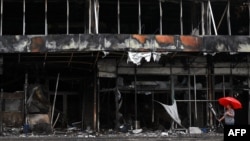ມັນເປັນຕອນເຊົ້າຂອງມື້ນຶ່ງ ເວລາທີ່ຊີວິດຢູ່ພາຍໃຕ້ການປົກຄອງຂອງຣັດເຊຍ ໄດ້ກາຍມາເປັນສິ່ງທີ່ທົນບໍ່ໄດ້ສຳລັບ ທ້າວໂວໂລດີເມຍ ເຊີດານອຟ (Volodymyr Zhdanov), ລູກສອນໄຟທີ່ຍິງແນໃສ່ກຳລັງຢູຄຣນ ໄດ້ຕົກລົງໃສ່ໃກ້ເຮືອນຂອງລາວຢູ່ໃນເມືອງເຄີສັນ (Kherson) ເຮັດໃຫ້ລູກຄົນນຶ່ງຂອງລາວມີຄວາມຢ້ານກົວ.
ລູກສາວຂອງລາວອາຍຸ 8 ປີຂອງລາວ “ໄດ້ແລ່ນດ້ວຍຄວາມຕື່ນຕົກໃຈລົງໄປຫ້ອງໃຕ້ດິນ. ມັນເປັນເວລາ 2 ໂມງ ຕອນເຊົ້າ ແລະລາວຢ້ານກົວທີ່ສຸດ” ທ້າວເຊີດານອຟ ໄດ້ກ່າວ, ຊຶ່ງຕໍ່ມາໄດ້ຫລົບໜີອອກຈາກເມືອງສູ່ທະເລດຳ ແລະໄດ້ມາຢູ່ ກິຢິບ (Kyiv) ເຊິ່ງແມ່ນນະຄອນຫລວງ ເປັນເວລາສາມອາທິດທີ່ຜ່ານມາ.
ເມືອງ ເຄີສັນ ຕັ້ງຢູ່ພາກເໜືອຂອງແຫລມໄຄຣເມຍ ທີ່ໄດ້ຖືກຍຶດຄອງໂດຍມົສກູໃນປີ 2014 ຊຶ່ງເປັນເມືອງທຳອິດທີ່ ໄດ້ເສຍໄປຫລັງຈາກການຮຸກຮານຂອງຣັດເຊຍ ໃນວັນທີ 24 ກຸມພາ. ທ່າເຮືອຍັງຄົງເປັນໝາກຫົວໃຈຂອງການຂັດແຍ້ງ ແລະຄວາມພະຍາຍາມຂອງຢູເຄຣນ ທີ່ຈະຮັກສາທາງຜ່ານທີ່ສຳຄັນໄປຫາທະເລ. ສຳລັບຣັດເຊຍ ເມືອງ ເຄີສັນ ເປັນຈຸດສຳຄັນທີ່ຢູ່ເລາະຕາມພື້ນທີ່ ຈາກຊາຍແດນໄປຫາແຫລມດັ່ງກ່າວ.
ທ້າວເຊີດານອຟ ແລະຄົນອື່ນໆຜູ້ທີ່ໄດ້ທຳການເດີນທາງທີ່ອັນຕະລາຍ ເພື່ອຫລົບໜີຈາກຂົງເຂດດັ່ງກ່າວ ໄດ້ບັນລະຍາຍເຖິງສະພາບອັນຕະລາຍທີ່ເພີ່ມຂຶ້ນຢູ່ທີ່ນັ້ນ ອັນເປັນພາກສ່ວນນຶ່ງຂອງຄວາມພະຍາຍາມໂຈມຕີຢ່າງໜັກໂດຍ ຣັດເຊຍ ເພື່ອທຳການຄວບຄຸມທີ່ຖາວອນ.
ຖະໜົນຫົນທາງຢູ່ໃນເມືອງດັ່ງກ່າວ, ເຊິ່ງກ່ອນສົງຄາມມີພົນລະເມືອງປະມານ 300,000 ຄົນ, ແມ່ນເກືອບວ່າໄດ້ ຮ້າງທັງໝົດ. ມີການຊ່າລືອອກມາກ່ຽວກັບວ່າ ມີພວກຕໍ່ຕ້ານຕິດອາວຸດປະຕິບັດງານ ແລະການຫາຍສາບສູນໄປໃນທັນທີຂອງພວກເຈົ້າໜ້າທີ່ ຜູ້ປະຕິເສດບໍ່ໃຫ້ການຮ່ວມມືກັບພວກເຈົ້າໜ້າທີ່ຣັດເຊຍ.
ກຳລັງທີ່ຄວບຄຸມລາດຕະເວນຢູ່ໃນຕະຫລາດ ໄດ້ເຕືອນພວກທີ່ພະຍາຍາມໃຊ້ເງິນ ໄຮເນຍ (hryvnia) ຂອງຢູເຄຣນ ສຳລັບການຊື້ຂາຍ. ພວກເຈົ້າໜ້າທີ່ ທີ່ສະໜັບສະໜູນ ຣັດເຊຍ ໄດ້ຖືກແຕ່ງຕັ້ງໃຫ້ປະຈຳການຢູ່ໃນທ້ອງຖິ່ນ ແລະລັດຖະບານໃນພື້ນທີ່ ພ້ອມທັງກຳລັງຕຳຫລວດ. ພວກພະນັກງານບໍລິການຢູ່ໃນໂຕເມືອງຕ່າງໆໄດ້ປະເຊີນໜ້າກັບຄວາມກົດດັນເພື່ອໃຫ້ການຮ່ວມມືກັບພວກຜູ້ບໍລິຫານຣັດເຊຍ. ໂຮງຮຽນສ່ວນຫຼາຍແມ່ນໄດ້ປິດລົງ.
ສະບຽງສິນຄ້າທີ່ສຳຄັນຕ່າງໆແມ່ນບໍ່ກ້ຳເກີ່ງກັນ, ແລະ ໄດ້ຢຸດກິດຈະການ ດ້ານການຄ້າເປັນສ່ວນໃຫຍ່. ມັນມີການຂາດເຂີນຢາປົວພະຍາດ ແລະຂຶ້ນລາຄາສິນຄ້າອື່ນໆ.
ຊາວບ້ານຫລາຍໆຄົນໄດ້ພາກັນຕັດສິນໃຈຢູ່ໃຫ້ດົນເທົ່າທີ່ຈະຢູ່ໄດ້ ໃນຄຳໝັ້ນສັນຍາຂອງການຕອບໂຕ້ໂດຍ ຢູເຄຣນ ທີ່ຍັງບໍ່ເປັນຮູບປະທຳ.
ທ້າວເຊີດານອຟ ກ່າວວ່າ “ມັນມີອັນຕະລາຍຕໍ່ຮ່າງກາຍຢູ່ໃນເມືອງ ເພາະວ່າໄດ້ມີທະຫານຢູ່ຫລາຍ.”
It was early one morning when life under Russian occupation became too much for Volodymyr Zhdanov: Rocket fire aimed at Ukrainian forces struck near his home in the city of Kherson, terrifying one of his two children.
His 8-year-old daughter “ran in panic to the basement. It was 2 o’clock in the morning and (she) was really scared,” said Zhdanov, who later fled the city on the Black Sea and has been living in Kyiv, the capital, for the past three weeks.
Kherson, located north of the Crimean Peninsula that was annexed by Moscow in 2014, was the first city to fall after Russia’s invasion on February 24. The port remains at the heart of the conflict and Ukraine’s efforts to preserve its vital access to the sea. For Russia, Kherson is a key point along the land corridor from its border to the peninsula.
Zhdanov and others who made the hazardous journey to escape from the region describe increasingly grim conditions there, part of a heavy-handed effort by Russia to establish permanent control.
The streets in the city, which had a prewar population of about 300,000, are mostly deserted. Rumors swirl about acts of armed resistance and the sudden disappearance of officials who refuse to cooperate with the Russian authorities.
Occupation forces patrol in markets to warn those trying to use the Ukrainian currency, the hryvnia, in transactions. Pro-Moscow officials have been installed in local and regional governments, as well as on the police force. Workers at various municipal services face pressure to cooperate with Russian managers. Most schools have closed.
Supplies of essential goods are uneven, halting most commercial activity. There are shortages of medicines and spikes in the price of other commodities.
Many residents had been determined to hold out as long as possible for a promised Ukrainian counterattack that hasn’t materialized.
“There was physical danger in the city, because there were many soldiers,” Zhdanov said.





